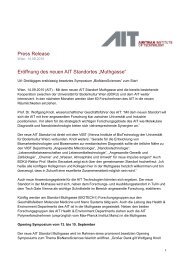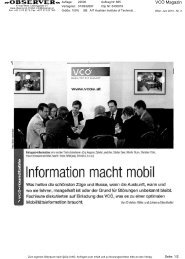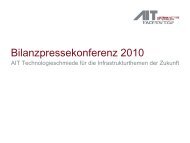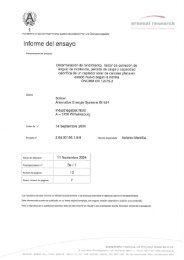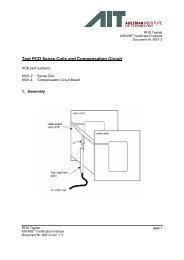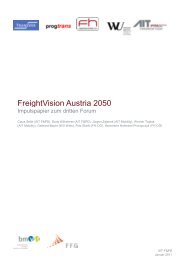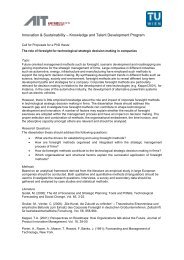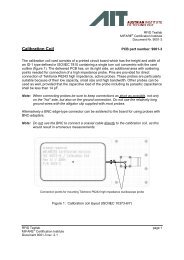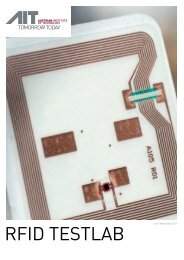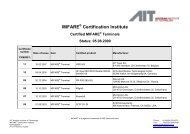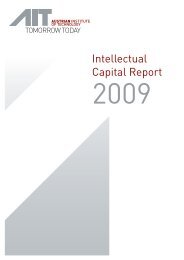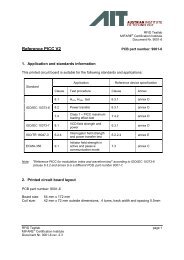Shareholders, Supervisory Board and management bodies ...
Shareholders, Supervisory Board and management bodies ...
Shareholders, Supervisory Board and management bodies ...
Create successful ePaper yourself
Turn your PDF publications into a flip-book with our unique Google optimized e-Paper software.
02<br />
Annual Report 2008<br />
Management report<br />
Structural report<br />
20<br />
Annual Report 2008<br />
Konzept (DG Demo Network Concept) project in 2008. In cooperation with Austrian system operators,<br />
researchers at the Energy Department developed flexible voltage <strong>management</strong> strategies<br />
aimed at maintaining supply quality even where there is a high proportion of distributed electricity<br />
generation. The outcome of the project was four innovative voltage control concepts which keep<br />
voltage within the specified limits <strong>and</strong> maintain security of supply even under conditions of increased<br />
distributed generation. Large-scale grid simulations were used to validate the new control concepts,<br />
<strong>and</strong> demonstrated that they were both technically <strong>and</strong> economically feasible. Not only did they<br />
enable a considerably higher density of decentralised generators to be integrated than with conventional<br />
methods, but in the network areas observed the alternative approaches were actually three<br />
to five times less expensive than the current strategy of network expansion. The next step will be to<br />
tailor the control concepts still more closely to real operational requirements, <strong>and</strong> validate them in<br />
practice over one to three years of demonstration operation.<br />
2.1.6.3 Mobility<br />
The Mobility Department focuses on developing solutions for environmentally sound, safe <strong>and</strong> cost<br />
<strong>and</strong> energy efficient mobility. The department‘s st<strong>and</strong>s out for its holistic approach which involves<br />
taking a systemic view of vehicles, infrastructure <strong>and</strong> personal transport. This in turn opens up new<br />
research perspectives.<br />
Light alloy frames <strong>and</strong> <strong>bodies</strong>, <strong>and</strong> electric drives for alternative vehicle design concepts<br />
Zero noise <strong>and</strong> exhaust emissions are the striking feature of the innovative sports model developed<br />
in 2008 by motorcycle manufacturer KTM Sportmotorcycle AG <strong>and</strong> the drive technology experts at<br />
the Mobility Department. Thanks to a powerful intelligent electric drivetrain that suits a wide range<br />
of riding conditions, the performance of the new motorcycle is comparable to that of conventional<br />
counterparts.<br />
The brief for the first zero emission KTM Enduro was to combine maximum performance <strong>and</strong> range<br />
with minimum vehicle weight. Developing the drivetrain involved selecting appropriate battery<br />
technology, designing the battery system including battery <strong>management</strong>, developing a safety <strong>and</strong><br />
control concept, <strong>and</strong> designing an optimised electric motor. Following promising trials, the zero<br />
emission prototype has moved from the research to the production ready development stage.<br />
Energy-efficient mobility dem<strong>and</strong>s new drive technologies <strong>and</strong> lighter vehicle structures. The<br />
department therefore focuses on novel methods for designing safe lightweight vehicle assemblies<br />
made of aluminium <strong>and</strong> magnesium alloys. Thanks to the greatly reduced machining costs in comparison<br />
to conventional body shells, the space frame — a structure consisting of extrusion sections<br />
<strong>and</strong> cast nodes — is ideally suited to low <strong>and</strong> very low volume production. The aim is to create<br />
space frames for a new generation of lightweight vehicles with alternative drives that meet existing<br />
safety st<strong>and</strong>ards.<br />
The simulation based development of a space frame structure for a lightweight electric drive vehicle<br />
was completed in 2008. The basic appearance of the vehicle was the starting point for defining the<br />
“packaging” — the exterior dimensions, wheelbase, <strong>and</strong> the position <strong>and</strong> weight of the electric motors,<br />
battery <strong>and</strong> driver. The project team developed software to compute stresses when cornering<br />
<strong>and</strong> braking, among other parameters. The packaging also determines the interior space provided<br />
by the frame. A body frame using light alloy profiles <strong>and</strong> cast nodes was virtually developed for this<br />
space <strong>and</strong> the other specifications.<br />
Dynamic optimisation of transport systems<br />
Dynamic <strong>management</strong> <strong>and</strong> guidance of large numbers of people is essential for the success of<br />
major events. The RAVE control system uses objective, automatically captured data to manage traffic<br />
flows at important hubs (such as railway platforms <strong>and</strong> entrances). Specially developed control<br />
rules translate information on traffic volume into instructions for portal <strong>management</strong>. Intelligent<br />
<strong>management</strong> like this maximises traffic throughput — for example, at large-scale events — <strong>and</strong>



